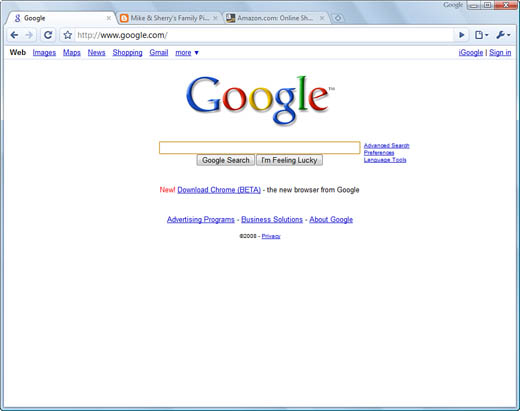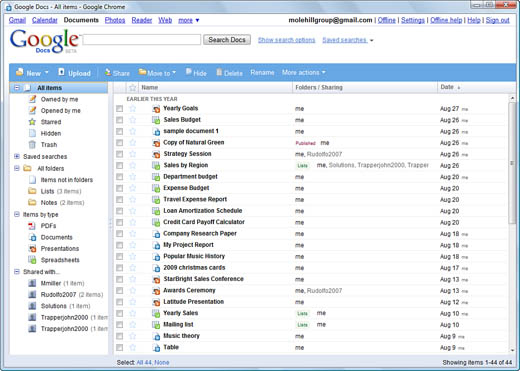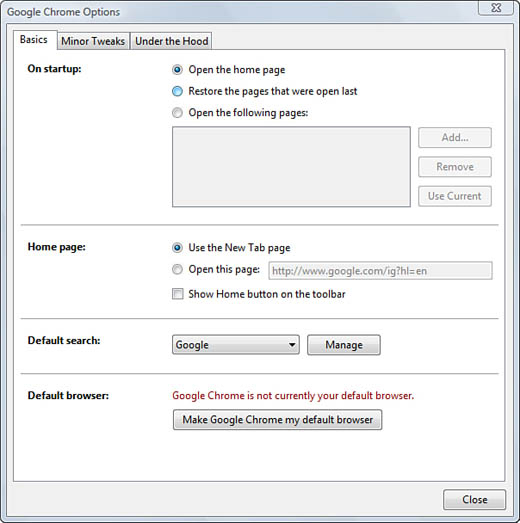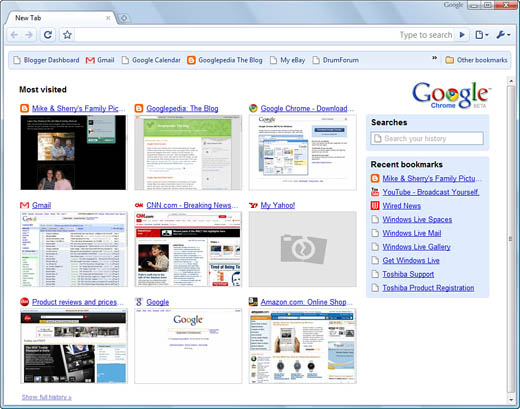Google Chrome is, first and foremost, a web browser, similar to Internet Explorer, Firefox, Opera, and Safari. That said, Chrome is actually more than a web browser; some have compared it to a web-based operating system, or at the very least an operating container for web-based applications. I’ll explain why in a few paragraphs.
First, let’s examine Chrome as a web browser. As you can see in Figure C.1, the Chrome interface resembles that of Internet Explorer and other modern web browsers, complete with tabs for different web pages. Chrome is a bit sleeker than the other browsers, however, with no menu bar, search bar, status bar, or other extraneous bits and pieces. This makes the web page bigger in the window, which isn’t a bad thing. In essence, it moves the business of the browser out of the way so that you can pay more attention to the web page itself.
Where Chrome really shines, however, becomes apparent when you use it to run a web-based application, such as Google Calendar or Google Docs. Select the right options, and your application appears in a window that resembles a traditional desktop application window rather than a browser; the tabs and the toolbars fade away so that all you see is the application itself, as demonstrated in Figure C.2. Even better, web-based applications run much faster in Chrome than they do in competing web browsers—more than 50 times faster than with Internet Explorer, or at least that’s what Google’s engineers claim.
Chrome’s speed is due partly to the stripped-down interface, but more likely is a result of the modern JavaScript engine used to run the browser. Chrome’s engine, dubbed “V8,” is designed to improve the performance of complex applications—just like the cloud computing applications that Google serves up to its millions of users.
Why is Google launching its own web browser? Isn’t Microsoft Explorer (or Firefox or Safari or Opera) good enough? Apparently not—at least when it comes to working from within the browser. The folks at Google, like many users, spend much of their computing time not working with traditional applications, but rather working inside the web browser. Whether it’s reading email via Gmail, checking appointments in Google Calendar, or working on documents and presentations with Google Docs, a lot of work gets done inside the browser. Unfortunately, today’s major browsers are based on technology originally developed more than a dozen years ago—and that technology was designed for the process of loading traditional HTML web pages, not for running dynamic web-based applications.
Thus Google’s interest in developing a new type of web browser optimized for running cloud applications. As I stated previously, Chrome is more of an application container or web-based operating system than it is a browser. To this point, Chrome doesn’t compete with Internet Explorer; it competes, instead, with Microsoft Windows itself. And that is something that Microsoft ought to be worried about.
Note
According to Google, the name Chrome derives from the “chrome,” or bells and whistles, that accompany a typical user interface. Google sought to minimize the “chrome,” which led to the browser’s name. (Others have pointed out that “chrome” was the name of an ill-fated multimedia technology product from Microsoft that was killed just days before release; this has been interpreted as a Google slam against Microsoft.)
You can download and install your copy of Chrome from www.google.com/chrome. Click the Download Google Chrome button, then sit back and let the installation take place.
After you have Chrome installed, you can import the settings and bookmarks (favorites) from your current web browser. Start by clicking the Tools menu and selecting Import Bookmarks & Settings. When the Import Bookmarks and Settings dialog box appears, pull down the list and select your web browser, check those items you want to import, and then click the Import button.
Note
As of September 2008, Chrome works only with computers running Windows Vista (any version) and Windows XP (Service Pack 2 or later). It does not currently work with Mac or Linux computers—although those versions are said to be in development.
Chrome also lets you configure a few other options. When you click the Tools menu and select Options, Chrome displays the Google Chrome Options window, shown in Figure C.3. There you find three tabs:
-
Basics. This tab lets you determine what happens when you launch Chrome, what page is used as your home page, which search engine is used by default, and whether Chrome is selected as your default web browser.
-
Minor Tweaks. This tab lets you select the default location for software downloads, choose whether to save the passwords you use, and select the fonts and language displayed in the browser.
-
Under the Hood. This tab contains some technical settings that you might need to adjust if you run into operational issues.
Most of us will get our first taste of Chrome when browsing the web. To that end, when you launch Chrome, it displays your nine most recently visited web pages, along with a list of your most recent bookmarks, as shown in Figure C.4. If you have pages bookmarked, they appear in bookmark bar at the top of the page.
To go to another web page, you type that page’s URL into what looks like a standard address box at the top of the browser window. This box is more than an address box, however; it’s an Omnibox that you also use to enter search queries.
When you start typing in the Omnibox, Google suggests both likely queries and web pages you are likely to visit, as shown in Figure C.5. Just select what you want from the drop-down list or complete typing your URL or query, and then press Enter.
If you’ve used Internet Explorer 7 or similar browsers, you’re already familiar with the concept of tabbed browsing. With tabs, you can open different web pages in different tabs, instead of opening one page after another, or using multiple browser windows.
Chrome makes good use of tabbed browsing. To open a new tab, just click the “+” button next to the current tab. You can also open a link in a new tab by right-clicking the link and selecting Open Link in New Tab.
Also neat is the capability to detach a tab and open it in a new browser window. Just drag the tab outside the current browser window and a new browser window opens. You also can add that page back to the original browser window, again by dragging and dropping.
Here’s another thing at which Chrome excels—downloading files from the Web. With most other web browsers, downloading is a chore that involves multiple dialog boxes and a lot of “OK” button-clicking. Not so with Chrome. When you choose to download a file with Chrome, it just happens. Chrome downloads the file without opening any dialog box; a small bar at the bottom of the browser window, shown in Figure C.6, shows the download progress (along with other recent downloads). When the download is finished, you can save it in any location by dragging the button for that download to the desired folder on your computer.
You may or may not know it, but most web browsers keep a record of every web page you visit. That’s fine, but every now and then you might browse some web pages that you don’t want tracked. To this end, Chrome offers what it calls Incognito mode, in which the pages you visit aren’t saved to your browser’s history file, cookies aren’t saved, and your activities are basically done without any records being kept.
To enter Incognito mode, click the Page button and select New Incognito Window. This opens a new window with a little spy icon next to the first tab, as shown in Figure C.7. When you’re done with your private browsing, just close the Incognito window and no one will be the wiser.
To me, the best thing about Chrome is how it runs web-based applications. Not only is it fast, it also lets you make a web-based application look and feel like a traditional desktop application.
To make a web-based application function like a desktop application, start by opening that application in a Chrome tab. Then click the Page button and select Create Application Shortcuts. When the Google Gears dialog box appears, select what type of shortcut to create: Desktop, Shortcut menu, or Quick launch bar. When you click OK, not only will a shortcut be created, but the application will open in a new “chromeless” window, like the one in Figure C.8.
This window functions like any traditional desktop application window. It can be resized, and when you next open the application, the window opens to the previously saved size.
In the future, you don’t even have to navigate to the application’s page on the web. You can open the application by clicking the shortcut you just created; the application opens whether you’re online or offline, just like a desktop app.
And here’s another great feature, especially if you’re running Google apps: Chrome has Google Gears built in, so you can run your applications whether you’re online or offline. This feature alone makes Chrome a worthwhile choice.
Note
Learn more about running web-based applications offline in Chapter 19, “Using Google Docs.” Learn more about the technology behind Google Gears in Chapter 46, “Using Google Gears.”







